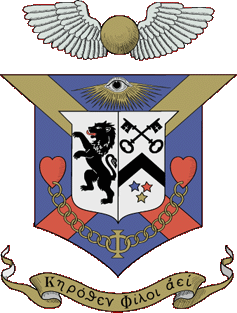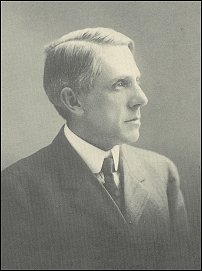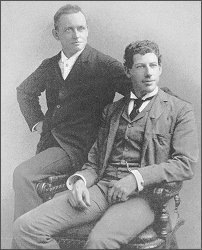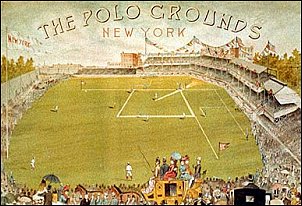|

Prominent
Alumni
|
ERNEST
THAYER '85 (1885)
Alpha
/ Harvard
 Ernest
Lawrence Thayer was born in Lawrence, Massachusetts on August 14th,
1863. Thayer, the son of a wealthy mill owner, was expected to go into
the family business, and attended Harvard where he majored in philosophy,
minored in humor and joined Delta Kappa Epsilon. He wrote one of
the annual Hasty Pudding Club plays and edited the Harvard Lampoon,
Harvard's long-running humor magazine. While he was at Harvard Thayer
became interested in baseball, and one of his best friends was Samuel
Winslow, captain of Harvard’s baseball team. He also became friends
with fellow Deke William Randolph Hearst, who was the Lampoon’s
business manager. Ernest
Lawrence Thayer was born in Lawrence, Massachusetts on August 14th,
1863. Thayer, the son of a wealthy mill owner, was expected to go into
the family business, and attended Harvard where he majored in philosophy,
minored in humor and joined Delta Kappa Epsilon. He wrote one of
the annual Hasty Pudding Club plays and edited the Harvard Lampoon,
Harvard's long-running humor magazine. While he was at Harvard Thayer
became interested in baseball, and one of his best friends was Samuel
Winslow, captain of Harvard’s baseball team. He also became friends
with fellow Deke William Randolph Hearst, who was the Lampoon’s
business manager.
After
graduation Hearst's father put him in charge of the San Francisco
Examiner, an ailing West Coast newspaper, and Hearst asked Thayer
to write a humor column for the paper. Presented with the choice of
writing humor columns for his school chum in San Francisco or managing
family woolen mills in Worcester, Massachusetts, Thayer, rather
unsurprisingly, packed his bags and headed for the West Coast. Thayer
began writing anonymously for the Examiner in 1886, and by 1887
he was contributing humorous poetry to the Sunday edition under the name
Phin. In February, 1888 he returned to the East and the woolen
mills, but sent several more pieces to Hearst, including the poem “Casey
at the Bat,” which was published on Sunday, June 3rd, 1888. Like
most works of enduring genius, Thayer’s ballad was greeted with little
fanfare, and it might have been quickly forgotten had not a writer named
Archibald Clavering Gunter thought enough of it to clip the poem out of
the paper that day and stick it in his wallet…
|

|
|
Digby
Bell (left) and De Wolf Hopper |
William
De Wolf Hopper was a giant of a man, 6’2” with an athlete’s build
and a deep, booming voice made for Shakespearian tragedy, but he chose
to perform comedy instead, and was working for the McCaull Opera Company
on Broadway in 1888. Hopper and his friend and fellow thespian
Digby Bell were both confirmed base ball cranks, and persuaded their
boss, Colonel McCaull, that the opera company should take advantage of a
game between the visiting Chicago White Stockings and the New York
Giants at the Polo Grounds for a day out and a bit of fun, and that they
should then invite the ballplayers to their evening show.
Hopper had wanted to include
some special material for his guests, but wasn’t sure what to perform.
Archibald Gunter, who was a friend of Hopper’s, suggested “Casey”
and pulled the tattered column from his wallet. Hopper wasn't sure. His
infant son was ill and he felt he could not concentrate enough to
memorize such a long poem. But his son improved and Hopper, a seasoned
professional, soon had the poem memorized.
 |
|
On August
14th, 1888, the Opera Company spent a festive day at the Polo
Grounds watching “Cap” Anson’s White Stockings beat their
Giants 4-2 (the same score the home team in "Casey"
would lose by), and then everybody, including both ball teams,
went back to the Opera House, where Prince Methusalem was
the featured show. At the end Hopper walked out onto the stage and
gave a stirring performance of “Casey at the Bat.”
|
“The audience literally
went wild,” reported the New York World the next day-
“Men got up on their seats and cheered… it was one of the
wildest scenes ever seen in a theatre”. By odd coincidence,
August 14th, 1888 also happened to be Ernest Lawrence Thayer’s 25th
birthday.
The poem made De Wolf Hopper
famous, and Hopper made the poem famous. By his own estimate he recited
it 10,000 times over the next decade; it took him exactly 5 minutes and
forty seconds each time. But almost nobody, including Hopper, had any
idea who had written it. In the early 1890s Hopper was performing in
Worcester, Massachusetts when he received an invitation to meet the
author. Thayer and his friends entertained Hopper at a private
club, and Thayer was persuaded to get up and give what Hopper would
later recall as one of the worst renditions of 'Casey' he had
ever heard. Hopper recalled- "In a sweet, dulcet Harvard
whisper he implored Casey to murder the umpire, and gave the cry of mass
animal rage all the emphasis of a caterpillar wearing rubbers crawling
on a velvet carpet".
Hopper asked Thayer that
evening who the inspiration for Casey was, and Thayer replied that it
was his old Harvard chum, baseball captain Samuel Winslow. Thayer
himself would later declare that there was no “real” Casey, and that
the name and vague image of Casey were drawn from a bully who once
threatened to beat him up in high school. Such mundane answers have, of
course, never satisfied baseball fans, who have come up with any number
of “real” Casey’s Thayer had in mind.
It took two decades for the poem to make Thayer famous, as he was
hardly the boastful type and had signed the June 3 poem with the
nickname "Phin". Two ongoing mysteries remained about the
poem: who, if anyone, was the model for the title character and whether
Thayer had a real-life "Mudville" in mind when he included
Mudville as the poem's mythical town. On March 31, 2004, Katie Zezima of
The New York Times penned an article called "In
'Casey' Rhubarb, 2 Cities Cry 'Foul!'" on the competing claims of
two towns to such renown: Stockton, California, and Holliston,
Massachusetts.
As far as whether there was any model for the title character, Thayer
already had dispelled the notion that any single living baseball player
was an influence. However, late 1880s Boston star Mike "King"
Kelly is odds-on the most likely model for Casey's baseball situations.
Besides being a native of a town close to Boston, Thayer, as a San
Francisco Examiner baseball reporter in the offseason of 1887-88,
covered exhibition games featuring Kelly. In November, 1887, some of his
reportage about a Kelly at-bat has the same ring as Casey's famous
at-bat in the poem. A 2004 book by Howard W. Rosenberg, Cap Anson 2:
The Theatrical and Kingly Mike Kelly: U.S. Team Sport's First Media
Sensation and Baseball's Original Casey at the Bat, reprints a 1905
Thayer letter to a Baltimore scribe who was inquiring about the poem's
roots. In the letter, Thayer singled out Kelly, who had died in 1894, as
having shown "impudence" in claiming to have written it.
Rosenberg argues that if Thayer still felt offended, Thayer may have
steered later comments away from connecting Kelly to it. Kelly had also
performed in vaudeville, and recited the poem dozens of times, possibly
butchering it to Thayer's dismay. Incidentally, the first public
performance of the poem was on August 14, 1888, by actor De Wolf Hopper,
on Thayer's 25th birthday.
Thayer's recitation of it at a Harvard class reunion in 1895 may seem
trivial except that it helps solve the mystery, which lingered into the
20th century, of who had written it. In the mid-1890s, Thayer
contributed several other comic poems for Hearst's New York Journal
and then turned to make his livelihood by overseeing his family's mills
in Worcester.
He moved to Santa Barbara, California, in 1912, where he married
Rosalind Buel Hammett and retired. Thayer died in 1940, at age 77.
|